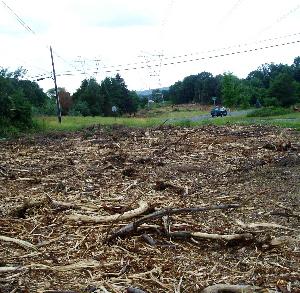Readington concerned about clear-cutting by utility companyUtility company says it must abide by stricter regulations
 |
| Two weeks ago, trees were clear-cut on the foreground property near the intersection of Hillcrest and Morningstar roads in Readington Township. The property is owned by PSE&G. Since then, PSE&G has clear-cut on property next to the power lines that is owned by Readington Township. |
READINGTON
TWP. – The township has added its voice to the chorus of protest
against clear-cutting under power lines that has laid bare swaths of
land up to hundreds of feet wide as a result of stricter regulations
for removing all trees and brush in power line easements.
“It
looks like a twister came through,” said Township Committeewoman Julia
Allen of several locations on township-owned and private property.
During the past several weeks, Public Service Electric & Gas
(PSE&G) company has authorized the removal of the large trees that
had only been cut back under the previous regulations and has increased
the width of clear-cut areas in easements, she said.
Allen said
piles of wood debris and brush are left behind in the path of the power
company easements, which she said measure as much as 300 feet wide
under double rows of large transmission towers carrying high
tension-wires.
PSE&G officials said they have no choice but
to follow the stricter regulations, the same answer given to Tewksbury
officials when they questioned clear-cutting in that municipality about
two months ago.
The stricter regulations regarding foliage
anywhere near power lines is the result of a large-scale, multi-state
power black-out in 2003, which was determined to have been caused by a
downed tree hitting a power line. That incident then cascaded into a
much larger problem, said Paul Rosengren, a spokesman for PSE&G.
‘Significant Fines’
“We face significant fines if we don’t follow the regulations exactly,” Rosengren said on Monday.
The regulations for all power companies are actually set by the state Board of Public Utilities.
The BPU is scheduled to review those regulations in August, said Doyal Siddell, public information officer, on Monday.
Allen
said Readington would try to join forces with other communities to urge
the utility companies to reconsider the regulations. She said the
Readington Planning Board has already sent such a request to the state
Board of Public Utilities, with copies of that letter mailed along to
state Sen. Leonard Lance, R-Hunterdon, the Association of New Jersey
Environmental Commissions and the New Jersey League of Municipalities.
“It’s really a statewide issue,” said Allen,
pointing to highly publicized reports in nearby Branchburg of one woman
chaining herself to a tree and another man suffering a heart attack as
they tried to prevent contractors hired by PSE&G from removing
trees.
Allen added that a state Department of Environmental
Protection official who happened to be heading along Route 523 “nearly
drove off the road” when he saw devastation caused by the clear-cutting
in a wooded area.
In Readington, one state agency, the New
Jersey Water Supply Authority, provided funding for the preservation of
land as a means of protecting the Holland Brook, but nearby debris left
behind from cut-down vegetation threatens the waterway, Allen said.
Large trees were being fed through chippers, leaving behind piles of
wood chips, she noted.
While a Tewksbury resident who complained
with backing from township officials was successful in having debris
removed from his land, Allen said that wood and brush has been left
behind in Readington.
Numerous Phone Calls
Township Administrator Vita Mekovitz said she has
received many phone calls from upset residents, including one on Monday
morning from a resident wondering if a nearby farmer was clearing land.
At
the June 18 Township Committee meeting, committee members said township
police had unsuccessfully tried to halt the clear-cutting.
Allen
said she received an e-mail with photos from a Brier Road resident in
late May of large-scale clear-cutting along the easement on his
property.
Under the BPU’s current regulations, Siddell said that
any vegetation that is likely to grow to within 15 feet of a line is
being removed, to allow for sag in the lines caused by ice, wind or
high temperatures.
“Vegetation management is a critical
component of an electric utility’s responsibility to provide safe,
reliable and adequate service to their customers,” Siddell said in a
written statement.
Trees that had never been removed during the 45
years that the power lines had existed in Readington are now being
taken out, Allen said.
Sections that had previously been trimmed were cleared out to a greater extent in the past four years or so, she observed.
Allen
said the previous guidelines had been for clearing access up to about
50 feet from the center line of an easement on either side.
But
now the guidelines seemed to have been changed to about 90 feet roughly
on either side, or about 180 feet surrounding transmission towers.
Surrounding
double towers, a clear-cut swath can spread out to about 280 to 300
feet in width, she said, adding that it doesn’t appear the widths have
been carefully measured.